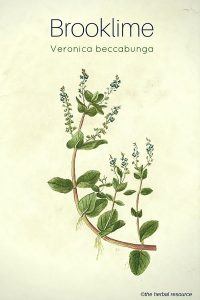The active substances found in brooklime are tannins, bitter substances such as Aucubin (an iridoid glycoside), phenolic acids, phytosterols, hydrocarbons, essential oil and some sulfur.
The medical effects of this herb are considered rather weak and are thought to be mainly due to the iridoid glycosides and phenolic acids.
Brooklime has very mild diuretic and laxative properties as well as a slightly fever-lowering effect.
This plant is not much used these days as an herbal medicine but it has had some application in folk medicine.
The herb was mentioned in the Pharmacopoeia of England and was recommended as an herbal remedy to treat scurvy and Scrofula, a form of tuberculous infection of the lymph nodes mostly in the neck.
Brooklime was also used in folk medicine as a herb to ease painful urination, to treat respiratory ailments such as colds and cough, for loss of appetite, constipation, dysentery, liver ailments and hemorrhoids.
In addition it has been used traditionally to treat atopic eczema, rashes, boils, burns and wounds.
In the past, it was used in conjunction with other vitamin C-rich plants like common scurvy grass (Cochlearia officinalis), as an herbal remedy to treat scurvy, and was then eaten as a salad.
If the plant grows in water which does not freeze in winter, the leaves remain green all year round and therefore it was used as a vegetable at times when there were otherwise few edible plants to find.

Leave a Reply